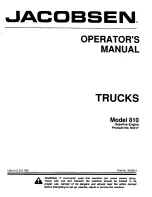
C AB A N D BODY M O U N T IN G S 1-80
EXPANSION VALVE REPLACEMENT
N O T E : When refrigeration system components
other than the compressor are replaced, the com
pressor must also be removed and oil drained
from the compressor if oil was sprayed in copious
amounts due to leaks or collision damage to valve.
See "Checking Compressor Oil Level and Adding
Oil" explained previously.
1. Depressurize the system.
2. Drain the cooling system.
3. Remove the evaporator and heater core
unit from under dash as directed later under "Evap
orator, Heater Core and Blower Replacement."
4. Remove the heater core from unit after re
moving unit lower cover.
5. Disconnect expansion valve capillary tube
bulb at evaporator outlet pipe.
6. Disconnect expansion valve equalizer line
at suction throttling valve.
7. Disconnect thermostatic expansion valve
inlet and outlet connections carefully, as some
pressure may still exist, and plug openings.
8. Separate unit upper cover, then lift out the
coil assembly. Remove expansion valve, noting
amount of oil that drains from fittings, and plug
openings.
9. Replace by reversing the previous pro
cedure, using new rubber O-ring seals, well lub
ricated with clean compressor oil, at each fitting
connection.
10. Evacuate and charge system.
11. Make a performance test.
SUCTION THROTTLING VALVE
REPLACEMENT
N O T E : When refrigeration system components
other than the compressor are replaced, the com
pressor must also be removed and oil drained
from the compressor if oil was sprayed in copious
amounts due to leaks or collision damage to core.
See "Checking Compressor Oil Level and Adding
Oil" explained previously.
1. Depressurize the refrigeration system.
2. Disconnect expansion valve equalizer line
at the suction throttling valve plug openings.
3. Disconnect suction valve to compressor
hose elbow.
4. Disconnect suction valve from evaporator
outlet. Remove two bracket attaching cap screws,
then remove valve.
5. Replace the suction throttling valve by re
versing the above procedures, using new rubber
O-ring seals, well lubricated with compressor oil,
at each connection.
6. Evacuate complete system.
7. Charge complete system.
8. Make a performance test.
EVAPORATOR HEATER CORE
ASSEMBLY REPLACEMENT
N O T E : When refrigeration system components
other than the compressor are replaced, the com
pressor must also be removed and oil drained
from the compressor if oil was sprayed in copious
amounts due to leaks or collision damage to valve.
See "Checking Compressor Oil Level and Adding
Oil" explained previously.
1. Depressurize the system.
2. Drain coolant.
3. Disconnect heater hoses at cowl.
4. Disconnect air distributor tube fromblower.
5. Disconnect all heating and cooling control
cables. Also, disconnect blower motor ground wire
at dash.
6. Disconnect refrigerant hoses from unit.
7. At base of unit, pull the drain tube from
floor opening.
8. Remove four screws which attach unit to
right side cowl. There are two at the top and bot
tom of unit.
9. At front of cowl remove single attaching
bolt. Carefully remove unit from cab.
10. Replace evaporator unit and blower motor
duct assembly by reversing previous procedures.
11. Evacuate and charge system.
12. Make a performance test.
COLLISION SERVICE
The severity and circumstances of the collision
will determine the extent of repair required. Good
judgment must be used in deciding what steps are
necessary to put the system back into operation.
Each part of the system must be carefully in
spected. No attempt should be made to straighten
kinked tubes or repair any bent or broken units.
Check especially for cracks at soldered connections.
R E F R IG E R A T IO N S Y S T E M
O P E N T O A T M O S P H E R E
Broken tubes or units will allow air, moisture
and dirt to enter. These parts should be sealed as
soon as possible until such time as they are re
placed.
If the system is open for more than 15 or 20
minutes (depending on humidity), the receiver-
dehydrator assembly will absorb an excessive
amount of moisture and should be replaced, and
each component of the system should be cleaned
with dry nitrogen and flushed with liquid refriger
ant to remove dirt and moisture.
F LU S H IN G S Y S T E M
Flushing can be accomplished by connecting a
refrigerant drum to the unit to be flushed and then
turning the drum upside down and opening the drum
CHEVROLET SERIES 70 -80 H EAVY DUTY TRUCK SH O P M A N U A L
Summary of Contents for 70 1969 Series
Page 1: ...CHEVROLET HEAVY DUTY TRUCK SHOP MANUAL...
Page 3: ......
Page 11: ...LUBRICATION 0 4 CHEVROLET SERIES 70 80 HEAVY DUTY TRUCK SHOP MANUAL...
Page 27: ......
Page 119: ......
Page 361: ......
Page 371: ......
Page 427: ......
Page 443: ......
Page 451: ......
Page 493: ......
Page 499: ......
Page 549: ......
Page 555: ......
Page 609: ......
Page 715: ...am...
Page 745: ......
Page 910: ......
Page 913: ......



































